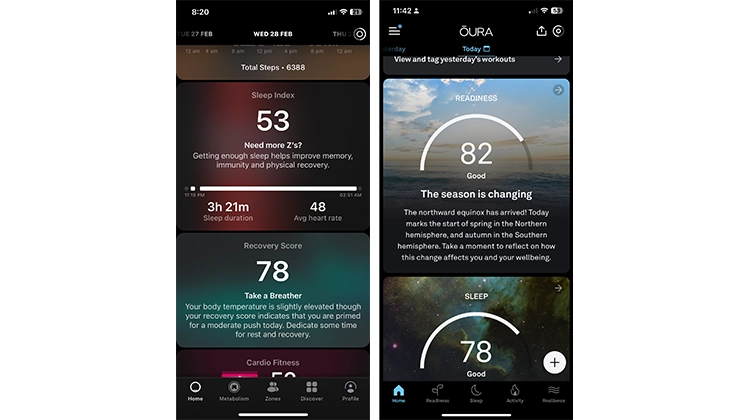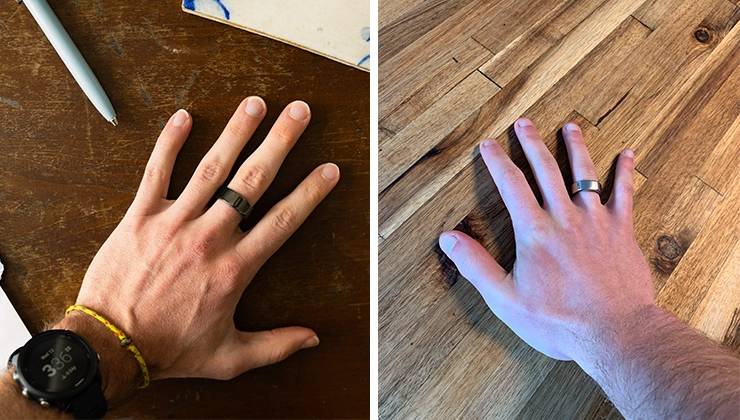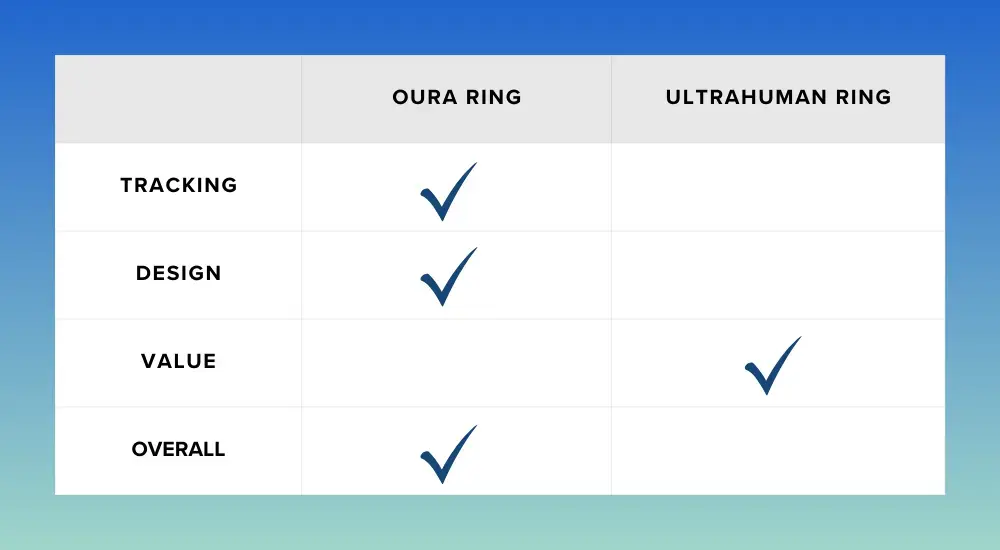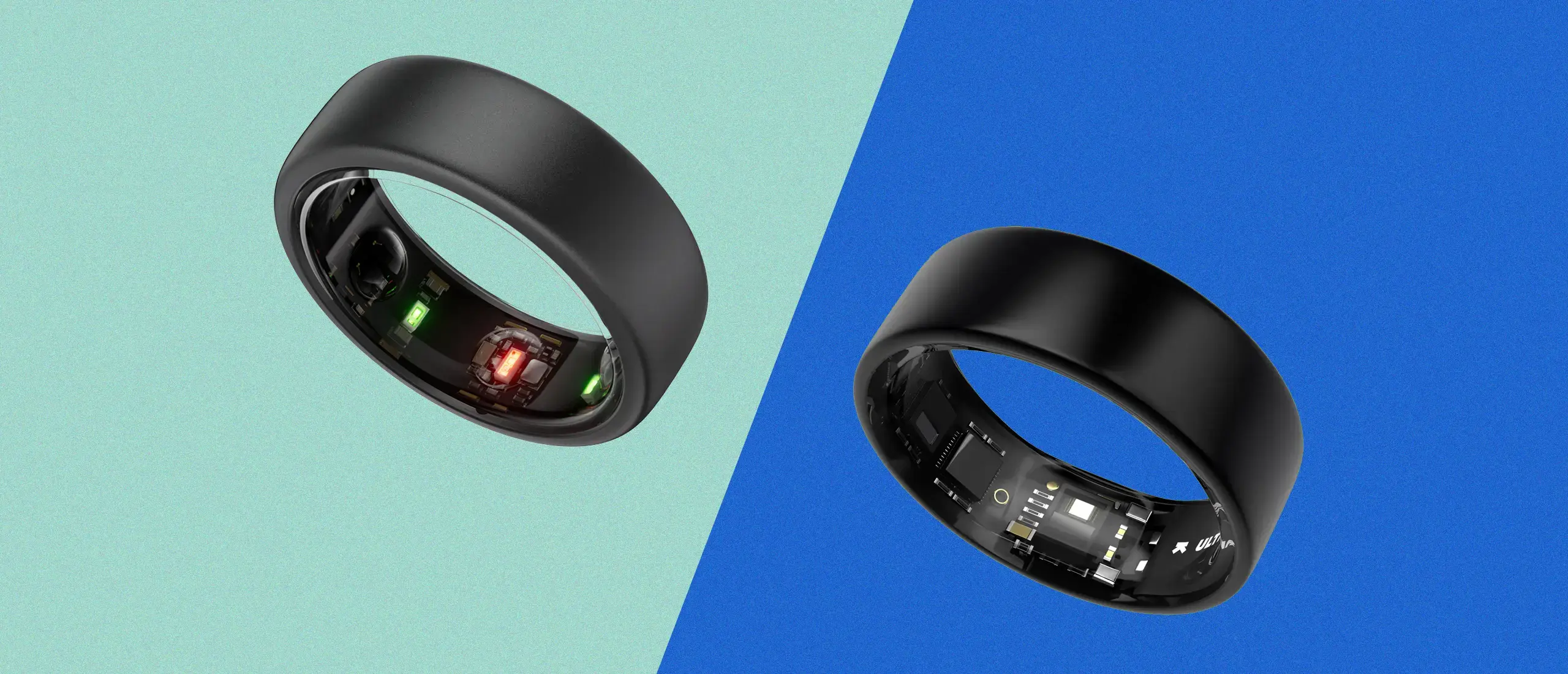Oura Ring vs. Ultrahuman: Which Is Better?
Our product recommendations are selected by editors, tested first-hand, or expert-approved. We may earn a commission through links on our site.
As technology gets smarter, so health trackers get smaller. Yes, Apple only does have a super-sized Apple Watch, but at the same time, a new category of less-invasive, wearable, vital sign-detecting device has emerged: the smart ring.
Instead of a tiny tablet with a sporty strap on your wrist, you can now keep track of your daily sleep habits and energy expenditure with a lightweight band affixed to your pointer finger. The big name in this game is Finland-based Oura, which launched its first ring in 2015. Recently though, Oura has received a challenge from the upstart Indian tech company Ultrahuman. It begs the question: Which smart ring is smarter, the established Oura Ring, or the new Ultrahuman Ring Air?
We’ve reviewed both the Oura Ring and the Ultrahuman Ring Air—here’s which we think is most worth your money.
Why You Should Trust Us
Hone Health is a team of health-obsessed journalists, editors, fitness junkies, medical reviewers, and product testers. To make sure we could make this comparison in a fair way, we tested both products for months before drawing conclusions. The reviewers of each ring have a combined 20 years of product reviewing experience, much of which spent getting hands-on with smart technology like these rings.
Oura vs. Ultrahuman
Before we get into our ring-versus-ring showdown, it’s worth noting that in September of 2023, Oura filed a lawsuit against Ultrahuman for patent and copyright infringement. In the brief, Oura asserts that Ultrahuman has conducted “a bold and deliberate effort to replicate the Oura Ring.” Ultrahuman’s founder, Mohit Kumar, responded confidently on Twitter/X and claimed that Oura has a history of acting litigiously. The outcome of the suit could have a significant impact on Ultrahuman’s operations.
1. Tracking
Both the Oura Ring and Ultrahuman Ring Air use a combination of LED sensors and motion detectors to monitor heart rate, heart rate variability, skin temperature, blood oxygen levels, and movement/steps. The companies use proprietary algorithms to process this raw data into easier-to-understand insights and overall “scores.” But there are some differences.
Oura Ring
Oura’s three big scores: Oura breaks its insights into three big categories: Readiness, Sleep, and Activity. Readiness draws on loads of body signals plus sleep information to give you a single-number sense of how primed for stress and activity you are on any given day.
The Activity score tracks heart rate, steps taken, and bouts of exercise to track whether you’re hitting a daily goal that you can set yourself. (It’s attempting to measure how many calories you burn, and it’s worth noting that studies have shown wearables are bad at doing this.)
The Oura Ring does have automatic activity detection—it can see some movement and a heart rate spike and guess that you went for a run, for instance—which is nice, but in our testing we found the activity tracking element to be a little lacking; it’s more of a retrospective tool (though you can “tag” bouts of elevated heart rate as exercise to give the data a little more credence).
Oura’s sleep tracking impressed us. The ring tracks awake time, REM sleep, light sleep, deep sleep, total sleep, resting heart rate, sleep efficiency, oxygen saturation, breathing regularity, HRV, and detects when you take a nap. There are interesting charts and graphs to look at, but the most helpful thing here is the score, which gives you an at-a-glance sense of your sleep. Importantly, the ring’s tracked sleep felt very accurate to our reviewer’s live experience, which was not the case with the Ultrahuman ring. More on that now.

Ultrahuman
Ultrahuman’s three big scores: Ultrahuman tracks, records, and displays sleep info very similarly to Oura. Its other two scores are slightly different though. First, there’s the Movement Index, which is akin to Oura’s Activity metric, though instead of showing you how close you are to hitting a goal—Ultrahuman has an entire block dedicated to individual goal progress like steps taken and going to bed early—it gives you a 1 out of 100. This number resets to 100 every morning and slowly decreases with inactivity and increases with frequent movement throughout the day. At the end of the day, this is your score for how well you did, and you can see a breakdown of when and how you moved.
The Ultrahuman Ring Air doesn’t have automatic activity detection, and its activity tracking feature is still in beta at the time of this writing. We tested it out and found that, like the Oura Ring, it’s not that great at accurately tracking runs and other workouts.
Ultrahuman’s third big number is the Recovery Score, which, like Oura’s Readiness, uses resting heart rate, HRV, temperature, sleep quality, movement, and more to give you a mark of how you’re doing.
In our testing of the Ultrahuman Ring Air, we found a lot of inconsistencies in the device’s ability to accurately and consistently keep tabs on our sleep and heart rate. These big numbers rely on combining all the data, so if one piece is significantly off, the whole picture becomes wonky. Ultrahuman is still a young company and the Ring Air is a new product, so we have hopes that it’ll improve with new firmware updates.
Tracking Winner: Oura Ring
We found both rings offered similar tracking capabilities, but the Oura Ring was significantly more accurate in most cases.
Design
Oura Ring
The Ring: The Oura Ring comes in two designs. There’s Heritage, which features a slightly ornate-looking “plateau.” Horizon is more of a classic, uninterrupted circle. Depending on which you opt for, there are several finishes to choose from: silver, black, matte black, brushed titanium, gold, and rose gold. The ring also has three little bumps on the inside where its sensors are housed, which act as markers to let you know how to wear it (the bumps should be on the bottom of your finger).
All Oura rings are made of PVD-coated titanium. They’re 2.55 millimeters thick, weigh four to six grams depending on size, and are waterproof to 100 meters. Inside that tiny shape is an optical heart rate sensor, blood oxygen sensor, photoplethysmography sensors, skin temperature sensors, photodiodes, and a 3D accelerometer.
We’ll also note the battery here. The Oura Ring lasts up to seven days, but we found in our testing that the average is closer to six.
The App: The accompanying Oura and Ultrahuman apps are quite similar in look and how data is organized and presented, but there are a few small differences. Oura puts its overall scores—Readiness, Sleep, and Activity—on the app home screen alongside info on heart rate, stress levels, and more. But it also separates these primary metrics into tabs at the bottom so that you can easily hop into each one to look at the nitty gritty, should you desire. We found in our testing that navigating through it all was pretty straightforward.

Ultrahuman
The Ring: The Ultrahuman Ring Air comes in one design; a classic circlet with a flat exterior (like the Oura Horizon). It’s available in black, matte gray, gold, and silver. Where the Oura Ring has bumps to let you know how to wear it, the Ultrahuman Ring Air has a small flat section where the sensors are. (We noticed during testing that you can occasionally see the LEDs glowing and twist the ring into position accordingly.)
Ultrahuman’s ring’s exterior is also titanium but includes a tungsten carbide coating. It’s lighter than Oura’s at 2.4 to 3.6 grams (varies by size). It’s also thinner at 2.45 to 2.8 millimeters (again, depending on size). It’s waterproof up to 100 meters. The sensor spec includes an optical heart rate sensor, blood oxygen sensor, photoplethysmography sensor, skin temperature sensor, and six-axis motion sensors.
The Ultrahuman Ring Air’s battery lasts up to six days. In our testing we found this to be true, but the ring nudges you to charge it more frequently than that; roughly every three to four days.
The App: Ultrahuman’s app is organized very similarly to Oura’s, with its three big scores (Movement Index, Sleep Index, Recovery) front and center on the home screen. Similarly, there are also blocks for other info like the Stimulant Restriction Window, Cardio Fitness, heart rate, skin temperature, and more. The page feels slightly more cluttered, bringing in a block for Ultrahuman’s macronutrient integration, a section dedicated to the Ultrahuman Store, and a big banner advertising $35 off for referring a friend.
The Ultrahuman app also uses bottom screen tabs, but these are dedicated to Metabolism, which is essentially an ad for its M1 Live continuous glucose monitor; Zones, which refers to Ultrahuman’s social element; and another for meditation, workout, and sleep content (Oura also has this one, to be fair). If you want to dig into your finer metrics, you’ll have to click in and out of them from the main screen. It’s just slightly more complex, but user experience is important.
Design Winner: Oura Ring
Oura narrowly edges out Ultrahuman with a better-designed app. The physical ring designs are similar enough to come down to personal preference of style and finish color.
Value
Oura Ring
The Oura Ring Heritage, with a sculpted “plateau” design, starts at $299 but also goes for $399 for matte black and $449 for gold. The classic smooth Oura Ring Horizon starts at $349 and jumps up to $449 for matte black and brushed titanium, $499 for gold, and $549 for rose gold. On top of the ring price, you’ll have to pay Oura’s $6/month subscription fee. Oura also offers protection plans: $45 for two years, and $60 for three.
Ultrahuman
The Ultrahuman Ring Air goes for $349, period, no subscription fees. Ultrahuman’s coverage plan costs $30 per year.
Value Winner: Ultrahuman
Everybody hates subscription costs for products that are already very expensive, and it’s for that reason we like Ultrahuman’s flat $349 pricing over Oura’s range of ring costs and monthly subscription fee to get the full suite of tracking insights.

What Do Smart Rings Do?
Smart rings slip into an emerging category of health wearables that passively collect piles of data on their wearers’ heart rate, heart-rate variability (HRV), daily step count, body temperature, sleep duration and efficiency, and more. The main goal these devices are built upon is habit monitoring and, as a possible result of that, adjustment.
How do smart rings work?
Like other health wearables, smart rings use temperature sensors, optical heart rate monitors, and motion sensors to obtain data. Their form and size create challenges for designers, but Marco Altini, a data scientist and developer who works in health tech, explains that there are also big pros with the format: “By measuring at the finger, we have direct access to arteries and can measure with higher signal-to-noise ratio, meaning that the data is higher quality with respect to what we get at the wrist, where we can only access superficial capillaries and are more prone to movement artifacts.”
Differences between smart rings and watches (and other wearables)
Lacking a screen, smart rings leave it up to the wearer to check in on themself in an accompanying app. These apps rely on proprietary algorithms that crunch the hard data into summary “scores”—like Oura’s Readiness score and Ultrahuman’s Sleep Index—so that wearers can understand their data without needing a PhD. The apps also supply suggestions on how to optimize one’s behavior via smartphone nudges.
While smart rings can track workouts and activities, it’s not their primary function. If you’re interested in keeping an eye on your pace while running or your heart rate zones while lifting, you’re better off with a watch that includes a screen so you can do so in real-time. Smart rings are more effective at pre- and post-activity number crunching; like seeing how primed your body is for a workout or analyzing how a particularly hard bout affected your biometrics. Many people opt for a smart ring over a watch or other wrist-based tracker because they’re more interested in sleep data than activity tracking.
Oura vs. Ultrahuman Overall Winner: Oura Ring
We prefer the Oura ring over the Ultrahuman option thanks to better tracking accuracy and a more navigable app. It’s not much of a surprise given the company’s multi-year head start in the smart ring space, and with Ultrahuman’s strong start and stronger price proposition, it might be a closer call as the more affordable option is updated and improved. For now, though, the Oura ring does the job better in all the ways that matter.









